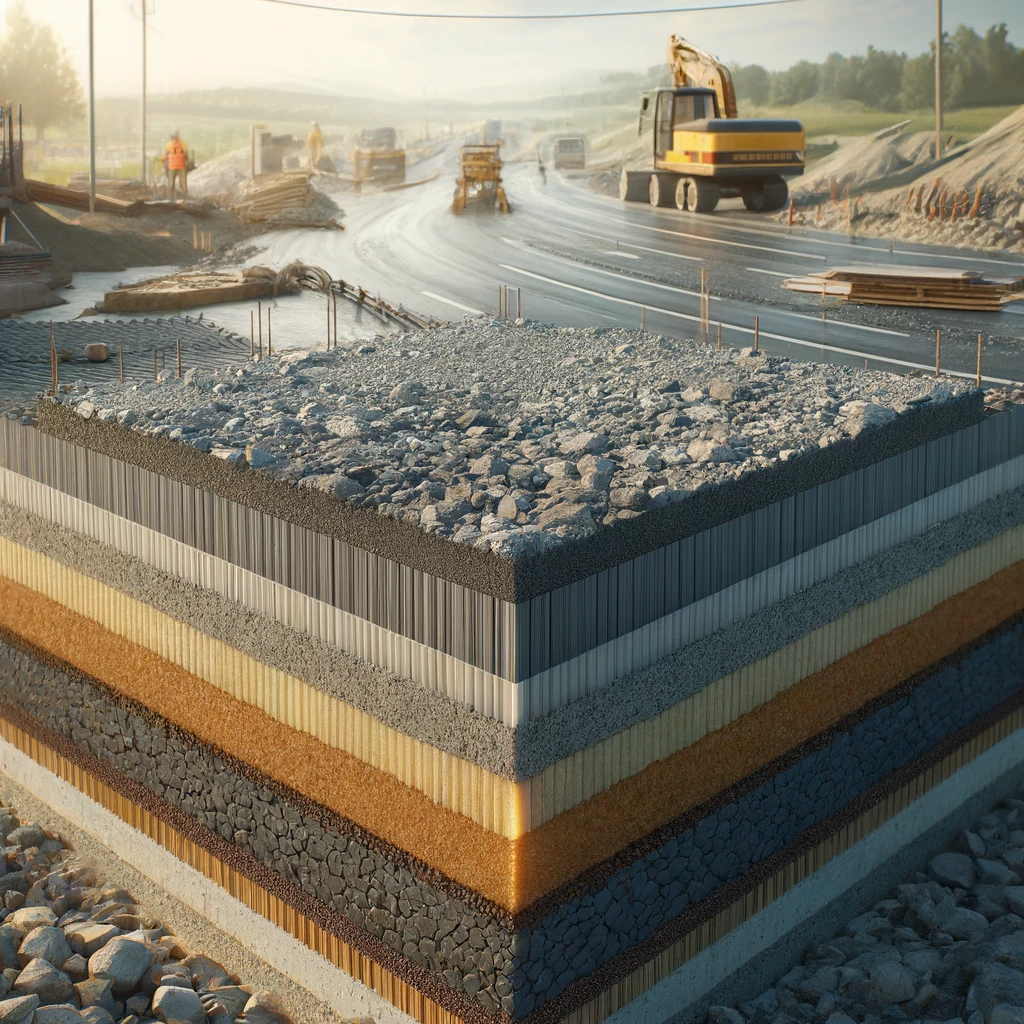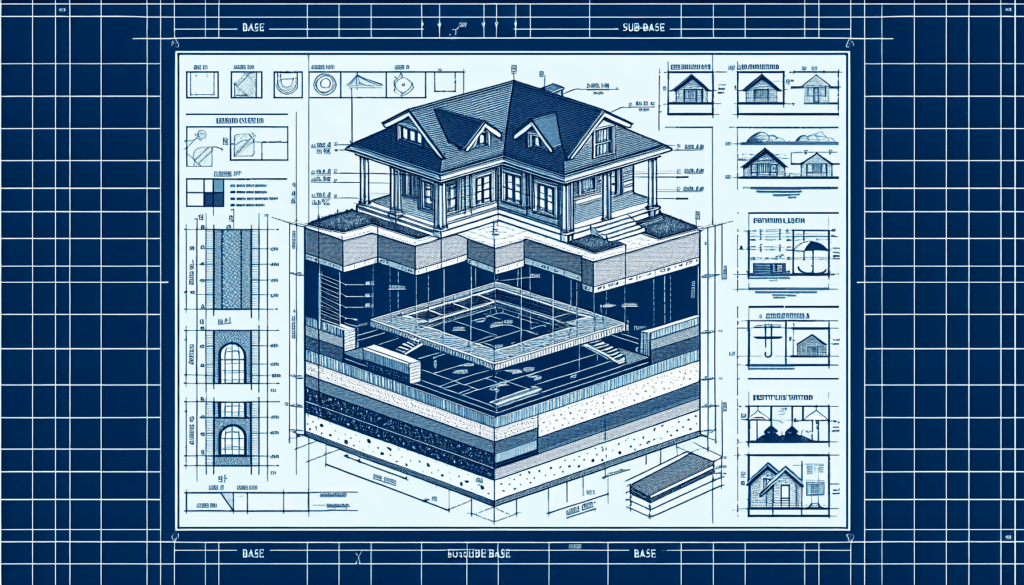Construction: The Importance of Base and Sub-base Layers
Base and sub-base layers are crucial to the durability and stability of all construction projects.
They provide foundational strength and help manage the distribution of heavy loads, ensuring the overall integrity of structures.
Defining Base and Sub-base Layers
Starting from the bottom, the sub-base layer offers initial support and drainage, adding to the ground’s existing capabilities. Rising a level, the base layer provides a solid platform upon which the rest of the construction is built.
Common Challenges
Issues like improper compaction, poor material choice, insufficient drainage, and uneven thickness can undermine the stability of these pivotal layers. Awareness of these potential pitfalls is key to prevention and early intervention.
Let’s jump in.

Table of Contents
Common Problems Encountered with Base and Sub-Base Layers in Construction
In construction, the base and sub-base layers are essential components of a project’s structural fortitude.
However, these layers can often face a variety of issues compromising overall construction quality. Understanding these problems is the first step toward successfully mitigating them.
Understanding Base and Sub-base Layers
Before delving into the problems, it’s vital to understand the role of base and sub-base layers in construction.
The Base Layer
The base layer lies directly underneath the pavement and serves as a strong foundation. It’s typically composed of crushed materials like limestone or granular materials like sand and clay.
The Sub-base Layer
The sub-base layer is located beneath the base layer. Its role includes providing additional support, improving drainage, and compensating for ground irregularities.
Problems with Base and Sub-base Layers
Both base and sub-base layers are critical in maintaining the structural integrity of a construction project. However, they can be affected by numerous issues.
Lack of Compaction
One notable issue is the lack of adequate compaction. Poor compaction can lead to settling or shifting over time, potentially resulting in the failure of the overlying pavements.
Improper Material Selection
Using incorrect aggregate materials for the base and sub-base layers can lead to the instability of the structure. The materials should be durable and capable of resisting weathering or traffic impact.
Insufficient Drainage
Poor drainage can lead to water retention in the sub-base layer, which can result in frost heave during colder months and a loss of support during warmer periods.
Uneven Thickness
The layers must be of uniform thickness for optimum performance. Unevenness could lead to low spots and eventual structural failure.
Tackling the Problems
Adherence to Specifications
Conforming to specified standards for material selection, layer thickness, and compaction is critical.
Regular Inspection and Maintenance
Regular checks ensure early detection and correction of potential issues. This could include addressing drainage issues or adding more materials to even out the layers as required.
Proper Construction Practices
Following recommended construction practices can help prevent base and sub-base layer problems. This includes only constructing in favourable weather conditions and keeping materials at the right moisture content during compaction.
A better understanding of the problems associated with base and sub-base layers, and how they can be avoided, can contribute to a more durable, higher quality construction project. For an in-depth look at your specific construction needs, consider contacting a reputable construction firm.

Understanding the Impact of Poor Base and Sub-base in Construction Projects
Consequences of a Poor Base and Sub-base in Construction
Failure to properly prepare the base and sub-base can seriously jeopardize the longevity, safety, and functionality of the construction project.
Decreased Lifespan
One of the primary impacts of poor base and sub-base quality is a decreased lifespan of the structure. Since these layers bear the load, insufficiently compacted or poor-quality material can lead to accelerated structural degradation.
Potential for Structural Failure
Poor base and sub-base quality may cause the upper layers of the construction to fail, leading to potential potholes, cracks, and even collapse in severe cases.
Elevated Maintenance Costs
Poor base and sub-base preparation can result in higher maintenance costs. Rectifying the problems post-construction tend to be more labor-intensive, time-consuming, and expensive than preventing them with a good base and sub-base.
| Consequence | Description |
|---|---|
| Decreased Lifespan | Premature structural degradation due to poor base and sub-base quality. |
| Potential for Structural Failure | Risks of potholes, cracks, and collapse caused by inadequate base and sub-base preparation. |
| Elevated Maintenance Costs | Increased cost, labor, and time for rectifying problems induced by poor base and sub-base. |
Preventing Poor Base and Sub-base Quality
Prevention is always better than cure. Here are some ways to ensure a good base and sub-base:
- Proper soil tests: Conduct geotechnical surveys to understand soil properties and choose the right materials.
- Compaction: Ensure sufficient compaction of both base and sub-base layers.
- Use of quality material: Only use high-quality, standard approved materials for these layers.
Conclusively, paying attention to the base and sub-base in construction projects is vital. Getting site preparation right from the beginning can save both time and money down the line, and most importantly, it could prevent catastrophic structural failures.
Further Learning
For those interested in learning more about construction industry standards and best practices, the ASTM’s road and paving standards are a valuable resource.
Determining the Thickness for Base and Sub-Base Layers: A Comprehensive Guide
How to Determine the Thickness Required
1. Geotechnical Investigation
Usually, the thickness of the base and sub-base layers is determined through a geotechnical investigation[1]. This investigation is designed to understand the physical properties of the soil and the behavior of the soil structure. Understanding the inbound soil’s properties helps in determining the required thickness of the base and sub-base layers.
2. Load Considerations
The expected traffic load or the type of building also affects the required thickness. For high-trafficked areas or heavy buildings, the layers will need to be thicker to withstand the increased load capacity.
3. Environmental Factors
Environmental factors such as ground water levels, freeze-thaw cycles, and climate considerations can also impact the base and sub-base thickness requirements[2].
General Guidelines for Thickness
Although the exact thickness can greatly vary depending on aforementioned factors, some general guidelines can be followed:
| Type of Construction | Base Thickness (approx) | Sub-Base Thickness (approx) |
|---|---|---|
| Residential driveways | 4 inches | 6 inches |
| Commercial parking lots | 4-6 inches | 8-10 inches |
| Heavy-traffic roads | 8-12 inches | 12-15 inches |
Concluding Notes On Base & Sub Base Layers
By understanding the importance of the base and sub-base layers, conducting a proper geotechnical investigation, and considering load and environmental factors, you can accurately determine the required thickness for your construction project.
We’ve found that base and sub-base layers are undeniably vital. However, they can be susceptible to problems like lack of compaction, improper material selection, insufficient drainage, and uneven thickness.
From our perspective, adhering to specifications, maintaining vigilance through regular inspections, and employing proper construction practices are practical ways to combat these issues.
Recognizing these problems and proactively addressing them not only safeguards the structural integrity of our projects but also contributes to their longevity.
No one-size-fits-all solution exists; therefore, for a comprehensive understanding of your unique construction requirements, we recommend reaching out to a credible construction firm. After all, in the world of construction, knowledge is the first line of defense against potential pitfalls.






